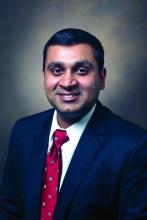Budesonide orodispersible tablets maintained remissions of eosinophilic esophagitis for 48 weeks in approximately 75% of patients and did not increase the risk for most adverse events, compared with placebo, according to the findings of a multicenter, randomized, double-blind trial.
While prior studies have shown that swallowed topical corticosteroids such as budesonide or fluticasone induce remission in EoE, this is the first multicenter phase 3 study of budesonide orodispersible tablets (BOTs) for maintaining remissions over the long term, wrote Alex Straumann, MD, of the Swiss EoE Research Group and University Hospital Zurich, and associates in Gastroenterology.
Eosinophilic esophagitis is the most common cause of esophageal dysphagia and food impaction. Swallowed topical corticosteroids improve symptoms and inflammation, but the off-label use of formulations developed for airway administration in asthma shows “suboptimal esophageal targeting and efficacy,” the researchers wrote. In the phase 3 EOS-2 trial, twice-daily treatment with 1.0 mg BOTs had induced clinicohistologic remissions in 58% of adults with EoE at 6 weeks and in 85% at 12 weeks.
To study long-term maintenance BOT therapy, the researchers randomly assigned 204 of the remitted patients to 48 weeks of twice-daily BOT 0.5 mg, BOT 1.0 mg, or placebo. There were 68 patients per group. A total of 141 patients completed this double-blind phase, but all 204 were evaluable for the primary analysis. The primary outcome was remission at week 48, defined as freedom from relapse (dysphagia or odynophagia rated as 4 or higher on a 10-point numeric rating scale), histologic relapse (≥48 eosinophils per mm2 high-power field), food impaction requiring endoscopic intervention, and dilation.
After 48 weeks, 51 patients in the 1-mg group (75%) and 50 patients in the 0.5-mg group (73.5%) remained in remission, compared with only three patients in the placebo group (4.4%; both P less than .0001). Patients in the placebo group relapsed after a median of 87 days off BOTs. Overall, BOT therapy was similarly efficacious regardless of factors such as history of allergic diseases, location of inflammation at the start of induction, or concomitant use of proton pump inhibitors. However, patients with inflammation of all three esophageal segments achieved “clinically relevant” greater rates of remission with twice-daily 1.0-mg BOT, compared with twice-daily 0.5-mg BOT (80% vs. 68%). In secondary analyses, rates of histologic relapse were 13.2% with 0.5-mg BOT twice daily, 10.3% with 1.0-mg BOT twice daily, and 90% with placebo, and rates of clinical relapse were 10.3%, 7.4%, and 60.3%, respectively. “Histological remission in the BOT 0.5 and 1.0mg twice daily group was independently maintained in all esophageal segments,” the researchers reported.
Rates of most adverse events were similar across treatment groups, and no serious treatment-emergent adverse events were reported. Average morning serum cortisol levels were similar among groups and did not change after treatment ended, but four patients on BOT therapy developed asymptomatic subnormal levels of morning cortisol. “Clinically manifested candidiasis was suspected in 16.2% of patients in the BOT 0.5mg group and in 11.8% of patients in the BOT 1.0mg group; all infections resolved with treatment,” the researchers wrote.
The study and editorial support were funded by Dr. Falk Pharma GmbH, a pharmaceutical company in Germany. Dr. Falk Pharma was involved in the study design and data collection, analysis, and interpretation. Dr. Straumann disclosed fees from several pharmaceutical companies, including Dr. Falk Pharma and AstraZeneca, which makes budesonide. Several other coinvestigators also disclosed ties to Dr. Falk Pharma, AstraZeneca, and other pharmaceutical companies.
SOURCE: Straumann A et al. Gastroenterology. 2020 July 25. doi: 10.1053/j.gastro.2020.07.039.

